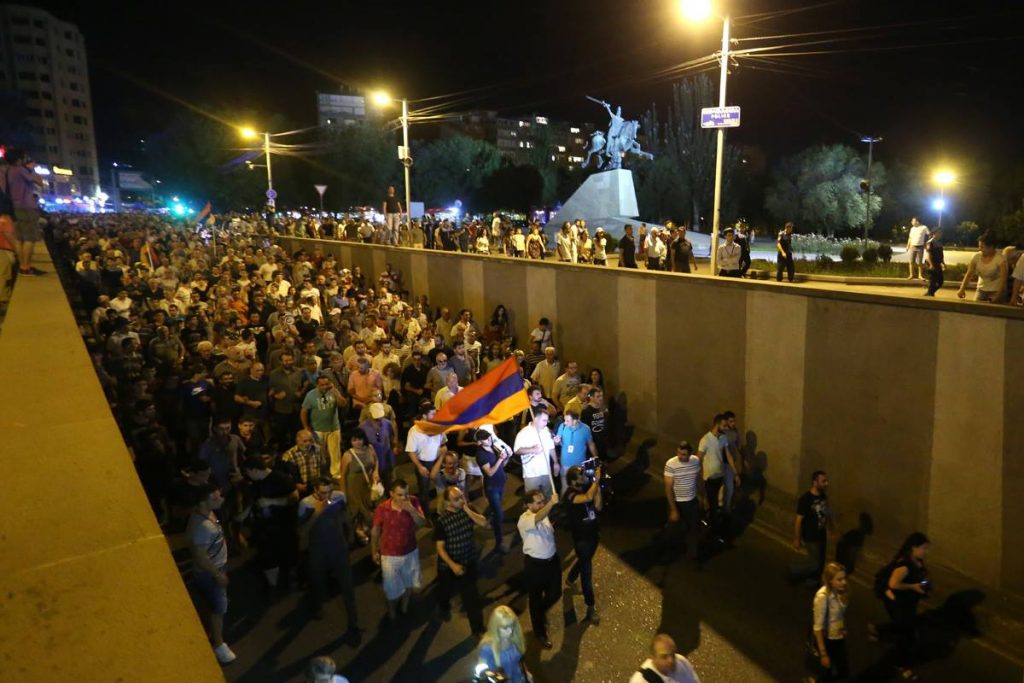For two weeks now, crowds have occupied Yerevan neighborhoods, resulting in several confrontations with riot police. Although the protests were sparked by the takeover of a police station by a militant group, it would be wrong to interpret the public reaction as loyalty to the individuals who have committed what can objectively be called a terrorist act. Instead, the crowds are sympathetic to the call for a change in leadership for the country. How did we get here?

‘The summers of 2013, 2014, and 2015 saw thousands of Armenians demonstrate on the streets of Yerevan.’ (Photo: Photolure)
One cannot overlook the detail that the armed militants, called “Sasna Tsrer,” include veterans of the Nagorno-Karabagh war of the 1990’s. One of their charges against the government of Armenia is that they were unable to prevent territorial losses in the recent flare-up of hostilities between Azerbaijan and Nagorno-Karabagh in April 2016. There are also allegations of peace deals, brokered by Russia, that would include further concessions of territory, although no authorities will confirm that such a deal exists.
The summers of 2013, 2014, and 2015 saw thousands of Armenians demonstrate on the streets of Yerevan, resisting moves that would worsen the economic burden on citizens. This protest is different, however. In addition to disenchantment with a rigged political-economic system that favors a small group of ruling elites, in the wake of the April 2016 attacks, there is also a glaring existential threat that has now crystallized. Although few are discussing it in the context of these protests, it has to do with the Armenian Genocide of a hundred years ago.
The Ottoman Empire was not content with only subjecting its own Armenian subjects to genocide. Once Anatolia was cleared of Christian Armenians, after Russia was knocked out of the First World War, the Turkish troops marched east to Transcaucasia to eliminate the Armenians who lived in what used to be the Russian Empire. It was part of a grand vision called Pan-Turanism, which would see Asia Minor united with Turkic Central Asia in a new theoretically ethnically homogenous state…without Armenians.
Fortunately, at Sardarabad, the advance was turned away by heroic Armenians who fought bravely to save their nation from extinction. Before the Turks could make a second attempt, the reins were handed to the Bolsheviks as the guarantor of Armenians’ survival.
A century later, much is still the same. Turkey is far from apologetic for the atrocities of its past. It attempts to exert its economic and geopolitical muscle to hush up mention of the genocide, even beyond its borders. It is still converting historic churches into mosques. Its diaspora attempts to intimidate Armenians on the anniversary of the genocide every year. It has conspired with ISIS in targeting Armenian populations in Syria. In April, Erdogan declared that he will support Azerbaijan in its war against ethnic Armenians “to the end.” Pan-Turanism is stronger than ever.
Given the opportunity, Turkey would not have any moral dilemma in trying to complete the genocide. The major impediment to NATO’s second largest military crossing the Araks river is the physical presence of the Russian army.
Because of the continuing Turkish threat, Russia knows how important it is to Armenia. It knows that the other powers of the world still squirm to admit that the genocide took place, never mind having any resolve to action if it were to restart. And so, Russia abuses its relationship. It isolated Armenia from the EU, annexed virtually its entire energy infrastructure, and demanded control over its airspace. One may swallow these bitter pills in the name of survival but, in the aftermath of April 2016, now that territorial concessions are in the picture, the shadow of the genocide has darkened the landscape. Russia’s Putin continues to sell weapons to Azerbaijan, stayed neutral when they were used against Armenians, and recently inked a rapprochement with an authoritarian Erdogan. He is proving to not be such a reliable guarantor of survival after all.
Ultimately, the responsibility to protect Armenians from genocide does not rest on Russia’s leadership but Armenia’s. The implications are not lost on the Armenian people. They want to see the plan. Serge Sarkisian is not offering one.
Source: Armenian Weekly
Link: The 2016 Yerevan Protests and the Armenian Genocide Connection
